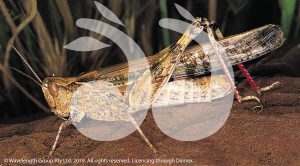Locust lookout
UPPER Hunter landholders are advised to look out for locusts this summer, as the reasonably wet spring may have helped produced a large summer generation.
“With the current favourable vegetation and further rainfall expected over the coming months, we anticipate a high level of survival of the nymphs that will hatch from the eggs currently being laid by adult locusts,” said NSW Department of Primary Industries (DPI) Plague Locust Commissioner Dr Andrew Sanger.
“Landholders have experienced their best harvest for several years and while some are looking forward to a break over summer, action is needed as the summer generation could easily balloon into a bigger hatching, that would severely impact autumn crops,” he said.

Australian plague locust, Chortoicetes terminifera. Photo supplied by NSW DPI.
Luke Booth, biosecurity team leader for Hunter Local Land Services said the first thing to look out for is a fly-in event.
“If anything is going to hatch you would have had to have had locusts fly in and lay . . . take notice of any areas where a large amount of locusts have come in and potentially laid,” said Mr Booth.
“Anywhere where previous hatchings occurred, it would be good for land owners to go back out and check those areas.”
Mr Booth said locust events are uncommon in the Upper Hunter when compared to central NSW however, as the shire emerges from drought, they may become more present.
“They lay on the hardest possible ground that they can find, so it’s often ridge-lines and hard rocky surfaces,” he said.
“Usually it’s the middle of NSW that is affected, they come from the channel country, thats usually where they hatch and the migration is usually down the centre of NSW down to Victoria.
“In order for the hatchings to occur, it needs to be a reasonably good season and then once they’ve hatched they need copious amounts of green feed to put body condition on to further their life stages in order to get on the wind to fly.
“The past three years of drought has meant that even if the were hatching, they weren’t finding good enough food to get through their growth stages and we weren’t having significant locust events.
“With the season we’ve had, the hatchings that we’ve had, there’s a pretty good chance that they are going to put on enough body condition.”
The Upper Hunter experienced its last minor hatching event twelve months ago, with what Mr Booth describes as “minimal activity.”
“If we were to name [hotspots], you could probably hazard a guess at Merriwa to Cassilis but last season we actually had some in and around Scone and Aberdeen, which was different,” he said.
“We sprayed and controlled what we could and now we’re just monitoring those areas so see if we get a second generation hatching.”
“What complicates thing is not just locusts that are hatching, there’s many other forms of grasshoppers with similar characteristics with Australian plague locusts, which sometimes can get people worried when there’s no need.
“We also know where these areas are in the Hunter and we’ll be monitoring with the help of land holders as best we can, but obviously we want land holders to have a look.
“If land holders are wanting any advice because they’ve got hatchings, just contact us or jump on the website to have a look at the identification of Australian plague locusts because they’re the ones that can band up, swarm together and do significant damage, so they’re the ones we’re interested in controlling as soon as we can,” said Mr Booth.
Reports of locust activity can be made directly to your Local Land Services officers on 1300 795 299, or to the Australia Plague Locust Commission on 1800 635 962 .
For further information or identification of locusts, visit the Local Land Services Website.
Tags: agriculture industry, crops, farmers, locusts, NSW DPI
 scone.com.au
scone.com.au